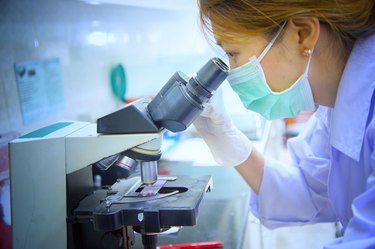
When small organic molecules bind together, they form larger molecules called biological macromolecules. Biological macromolecules fall into four categories: carbohydrates, proteins, lipids and nucleic acids. Your body uses carbohydrates, lipids and proteins for energy. The only biological macromolecule not used for energy is nucleic acid. Nucleic acids hold and transcribe your genetic code.
Protein
Video of the Day
Isolate any cell in the human body and you will find a protein. The human body produces 100,000 different proteins, according to Dr. Harvey Simon, editor of Harvard Men's Health Watch. Small organic molecules called amino acids bind together to form the biological macromolecule protein. Protein is the building block of hair, blood cells, muscles and enzymes. If you consume more protein than your body needs, it converts into fat. Humans use protein as a last resort energy reserve.
Video of the Day
Carbohydrates
All sugars belong to a group of biological macromolecules known as carbohydrates. Carbohydrate molecules contain carbon, hydrogen and oxygen. These elements combine to form a sugar molecule. The nature of a carbohydrate depends on the number of sugar molecules bonded together and the orientation of the carbon, hydrogen and oxygen atoms. Humans use carbohydrates as the first source of energy. When you consume excess carbohydrates, the liver converts some into fat and stores a portion as the long chain sugar molecule glycogen. The human body does not use any other source of energy until glycogen reserves run out.
Lipids
Do not underestimate the power of fat because your body needs it to thrive. Biological macromolecules called lipids come in two forms, triglycerides and phospholipids. Triglyceride, also called fat, acts as an energy storage medium for the human body. Fat plays an important role in vitamin absorption, blood clotting, regulation of inflammation and brain development. After energy from carbohydrates runs low, your body burns fat as a secondary energy source. Phospholipids make up your cell membrane and prevent unwanted items from entering the cell. Triglyceride and phospholipids contain glycerol and fatty acid chains. Fat molecules differ from phospholipids in that fats do not contain a phosphate group.
Nucleic Acid
The biological macromolecule nucleic acid occurs in two forms: deoxyribonucleic acid, or DNA, and ribonucleic acid, commonly known as RNA. DNA contains the blueprint for your genetic code. RNA reads the blueprint found on DNA and produces proteins based on the genetic code. While you will only find DNA inside a cell, some RNA exists outside of the cell. The RNA outside of the cell manufactures proteins. The human body does not use nucleic acid for energy.